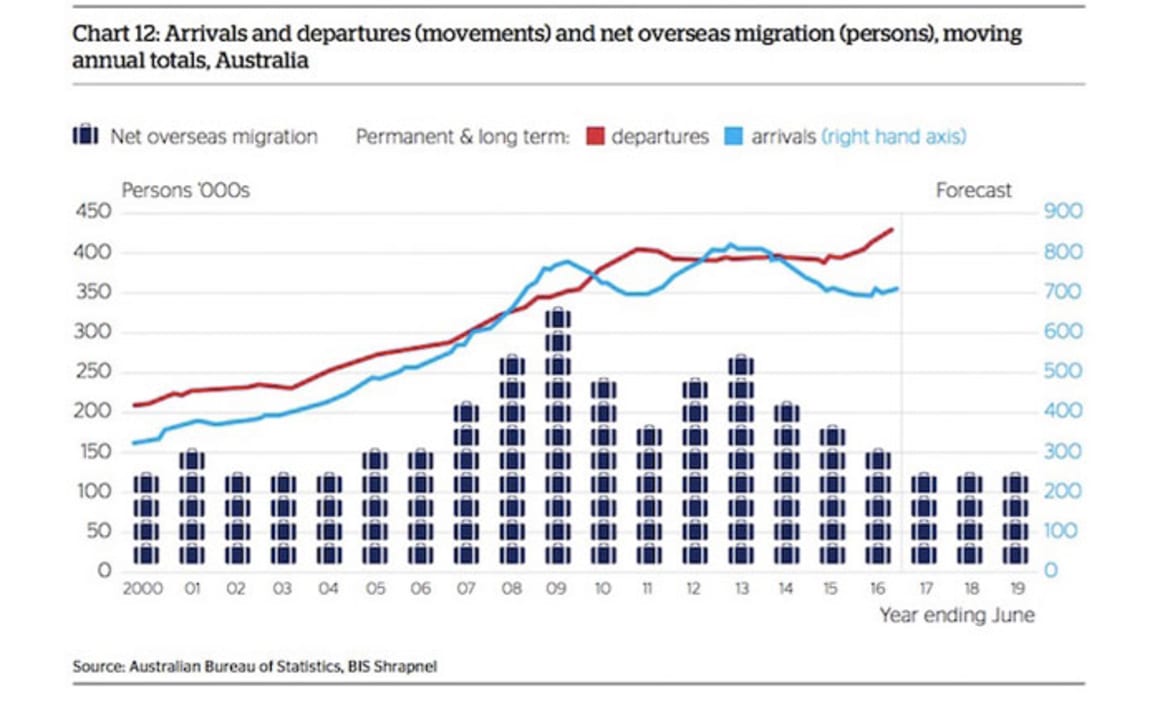Overseas migrants in decline: QBE Housing Outlook

Underlying demand for new dwellings is driven primarily by population growth which, at the state level, is a combination of an increase in births less deaths and net overseas and net interstate migration flows, according to QBE’s latest housing report.
The demand from net overseas and net interstate migration is more immediate because this group typically requires accommodation upon arrival, be it owner occupied or rental. Net overseas migration refers to the balance of arrivals to, and departures from, Australia. To be included in this calculation, an arrival is counted if they are resident in the country for 12 out of 16 months.
Long term arrivals – which predominantly comprise people on student or skilled temporary subclass 457 visas – surged to an annual record of 516,000 in the year to March 2013. Solid employment growth in mining sector related industries resulted in a re-emergence of skills shortages which underpinned the rise in long term overseas visitors.
Although arrivals from overseas were at record levels in March 2013, departures from Australia were also increasing, with the net effect that net overseas migration was below the record levels set in 2008.
Since the second half of 2013, long term arrivals have contracted in response to the slowing conditions in the Australian economy. There has been a decline in work–related visas such as subclass 457 visas as the reduction in the resource sector investment leads to diminished employment opportunities.
Long term departures are on the increase as temporary migrants return to their country of origin upon expiry of their visas. Net migration from New Zealand has also declined in this period because its economy has improved relative to Australia.
With the decline in annual net inflow from long term arrivals, net overseas migration has decreased to an estimated 155,000 at June 2016. Falling arrivals and increasing departures, due to the lack of opportunities for temporary migrants to extend their stay, is forecast to continue, taking net overseas migration to a low of 140,000 in 2017/18 and 2018/19.
While lower than recent peaks, this figure is elevated in a long term sense, being higher than most years through the 1990s and early 2000s. There may be some upside to these forecasts.
Strong growth is occurring in international student enrolments, with the number of overseas students commencing courses in Australia increasing by 42% in the three years to 2015/16, and net overseas migration could be higher if many elect to stay on.
Average annual net overseas migration over the 2016/17 to 2018/19 period is forecast to be lower across all states (with the exception of the Australian Capital Territory) than the long term 1999/2000 to 2015/16 average.
The largest declines are expected to be in the states where net overseas migration inflows have been high as a result of skills shortage generated by booming resource sector investment.

The forecast share of national net overseas migration in Western Australia (8.0%), Queensland (12.0%) and Northern Territory (0.5%) over 2016/17 to 2018/19 will be significantly lower than their long term average.
Weak employment prospects as mining investment continues to decline will encourage more overseas migrants to settle in the other states, while overseas migrants employed on temporary working visas are increasingly returning home as projects wind up.
Growth in overseas migration into New South Wales and Victoria lagged that of the resource states during the mining investment boom. As a result, the states are not experiencing rising outflows of temporary workers. Moreover, with the strongest performing state economies, these states are also attracting a greater share of arrivals.
The states are forecast to attract an average 40.1% and 31.3% of Australia’s net overseas migration respectively between 2016/17 to 2018/19; higher than their long term average share. The Australian Capital Territory is also forecast to attract an increased share of national net overseas migration.
Overseas students look to be one of the few components of net overseas migration to increase. Australian National University has a large overseas student population, which has an influence in a smaller city such as Canberra.
As with New South Wales and Victoria, net overseas migration into South Australia and Tasmania was also behind the resource states.
With economic conditions remaining challenging in these states, their share of national net overseas migration over 2016/17 to 2018/19 is forecast to be similar to their recent average since 2007/08 (6.0% and 0.7% respectively).